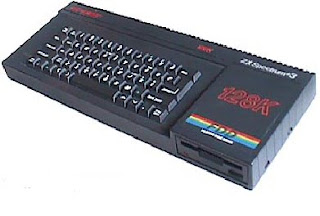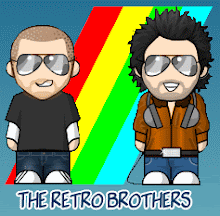 ZX Spectrum +3
ZX Spectrum +3The final lump from Sugar is just not quite sweet enough.
Ahh, the ZX Spectrum plus 3. This was the final incarnation of the famous ZX Spectrum machine manufactured by Amstrad. It was released onto the UK market in 1987 and is generally heralded as the finest of the ZX series. (It is generally noted that after 1987 the ZX Spectrum and it's classic games scene began a slow decline as the new 16-bit machines took over.)
The Sinclair Spectrum +3 was the successor of the ZX Spectrum +2 which had been marketed roughly one year earlier. The Spectrum +3 can be considered as a 'mix' between the Spectrum 128 and the Amstrad CPC 6128. Like this machine it has 3’’ disk-drive built into the right hand side of the case and a 'proper' full-stroke keyboard, just like the CPC 6128.
As on the Spectrum +2, two BASIC versions were implemented:
- 48K BASIC to remain compatible with the original Sinclair ZX Spectrum 48K - which allowed the loading of older software and those all important classic games
- 128K BASIC which was already introduced with the Spectrum 128.
As with the others 128K models, and due to the limitations of the Z80 CPU (which can only address 65536 bytes), the 128KB of RAM is not directly usable (unless with bank-switching routines) but can be used as a RAM disk (drive M :).
Locomotive Software also went full steam ahead and conceived the CPC Basics and OS. We can sense a pattern emerging here, the +3DOS is very close to the CPCs disk operating system. The Amstrad FD-1 external drive can even be used with the Spectrum +3 as a second disk drive by connecting it directly to 'DISK B PORT' at the back of the system.
The Spectrum +3 was (and by many still is) considered the ultimate Spectrum model as it gathered all of the good points of the previous spectrum machines:
- 128KB
- Convenient full-stroke keyboard
- 3’’ built-in disk drive
- RAM disk
- More interfaces than R2D2
- Existing huge library of computer games (both text adventures and arcade games) - many of them already classic games
Sadly, this machine was launched just a little too late. The Atari ST and the Commodore Amiga, (new, powerful, hooked into EVERYTHING. They decided the Spectrums fate in a microsecond) were becoming more popular and both used disk drives as a storage medium.
The Spectrum + 3 had no advantages over these machines apart from existing software library and price. The C64 and Spectrum rivalry had shifted and the competition was now on between the Atari ST and the Commodore Amiga. Shelf space for the new Spectrum was limited.
The +3 was the last official Sinclair Spectrum model ever made, apart from the +2A and +2B models which were launched a little later, but these were just a revision of the +2 model which was already on the market.
Many people did not want to spend money to buy existing games on disk, and stuck with cassette versions of games (in a smart move a standard tape deck could be connected to the +3).
Many of the classic games were only available on cassette and did not get a disk release either. Also, like the +2, it had that 'Amstrad' feel to it, you just knew it was not one of Uncle Clive's machines. (It was still a decent looking machine though, the built in disk drive was quite snazzy.)
Consequently the +3 never reached the heights of its predecessors. Still, the +3 was a fine machine to bring the Spectrum era (and a certain era of arcade gaming) to a close.
Give it a round of applause for helping to usher in the 'built in disk drive' era. A fine retro computer.
To see further information about games, developers and software houses for this machine, go to Spectrum Games
For more general Speccy info and vids go to Sinclair ZX Spectrum
We recommend trying to pick up one of these machines.
Look at computers for sale online or even locally.
If you don't want to get hold of the real hardware then try and download an emulator and download those classic games. Alternatively you could try and play them online.
MACHINE NAME: ZX SPECTRUM +3
MANUFACTURER: Sinclair
MACHINE TYPE: Home 8-Bit micro (a premier computer games machine)
COUNTRY OF ORIGIN: United Kingdom
RELEASE YEAR: 1987
BUILT IN LANGUAGE(S): 48K Spectrum BASIC (compatibility mode) and 128K Spectrum ZX+3 BASIC, integrated with +3 DOS
KEYBOARD: Full-stroke keyboard, QWERTY, 58 keys, arrow keys
CPU: Zilog Z80 A
SPEED: 3.5469 MHz
RAM: 128 kb (8 x 16k pages)
ROM: 64 kb (4 x 16k pages)
TEXT MODES: 32 x 24
GRAPHIC MODES:256 x 192
COLORS: 8 with two tones each (normal and bright except Black which was only in 1 tone)
SOUND: 3 channels over 8 octaves (Yamaha AY-3-8912 chip)
SIZE / WEIGHT: 440 x 174 x 50 mm / 1,65 kg
I/O PORTS: Really great - UHF PAL TV port, Serial interface (RS232) port, Parallel Printer port (8 bit), Auxiliary interface port, RGB Monitor (and PERITEL TV) port, MIDI output port, Two Joystick ports, Audio Out/Cassette port, Second Disk Drive port, Expansion I/O port (full Z80 bus)
BUILT IN MEDIA: 3'' Hitachi Floppy Disk Drive, single sided (40 track, 9 sector, 512 bytes/sector), CP/M compatible structureVolatile RAM Drive
OS: +3DOS
POWER SUPPLY: External PSU (5V @ 2A, +12V @ 700mA, -12V @ 50mA)Same as Spectrum +2A/B PSU
PRICE: £249 (UK 1987)
Retro Computers and classic games




2 comments:
I had one, good point about the disks, they were hard to get hold of at 1st.
Not waiting long to load your games was a bonus and been able to access the ram disk was handy for programming as with the +2.
Nice machines.
excellent post, very informative. I wonder why the other experts of this sector do not notice this. You should continue your writing.
free brain games for adults
Post a Comment